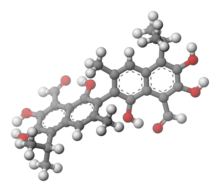
| |

| |
| Names | |
|---|---|
| Preferred IUPAC name
1,1′,6,6′,7,7′-Hexahydroxy-3,3′-dimethyl-5,5′-di(propan-2-yl)[2,2′-binaphthalene]-8,8′-dicarbaldehyde | |
| Identifiers | |
3D model (JSmol)
|
|
| ChEMBL | |
| ChemSpider | |
| DrugBank | |
| ECHA InfoCard | 100.164.654 |
| KEGG | |
PubChem CID
|
|
| UNII | |
CompTox Dashboard (EPA)
|
|
| |
| |
| Properties | |
| C30H30O8 | |
| Molar mass | 518.562 g·mol−1 |
| Appearance | Brown solid |
| Density | 1.4 g/mL |
| Melting point | 177 to 182 °C (351 to 360 °F; 450 to 455 K) (decomposes) |
| Boiling point | 707 °C (1,305 °F; 980 K) |
| Hazards | |
| GHS labelling: | |

| |
| Warning | |
| H351 | |
| P201, P202, P281, P308+P313, P405, P501 | |
Except where otherwise noted, data are given for materials in their standard state (at 25 °C [77 °F], 100 kPa).
| |
Gossypol (/ˈɡɒsəpɒl/) is a natural phenol derived from the cotton plant (genus Gossypium). Gossypol is a phenolic aldehyde that permeates cells and acts as an inhibitor for several dehydrogenase enzymes. It is a yellow pigment. The structure exhibits atropisomerism, with the two enantiomers having different biochemical properties.[1]
Among other applications, it has been tested as a male oral contraceptive in China. In addition to its putative contraceptive properties, gossypol has also long been known to possess antimalarial properties.[2]
- ^ Beise, Chase L.; Dowd, Michael K.; Reilly, Peter J. (2005). "Conformational analysis of gossypol and its derivatives by molecular mechanics". Journal of Molecular Structure: THEOCHEM. 730 (1–3): 51–58. doi:10.1016/j.theochem.2005.05.010.
- ^ Dodou, Kalliopi (2005-10-28). "Investigations on gossypol: past and present developments". Expert Opinion on Investigational Drugs. 14 (11): 1419–1434. doi:10.1517/13543784.14.11.1419. ISSN 1354-3784. PMID 16255680. S2CID 32120983.